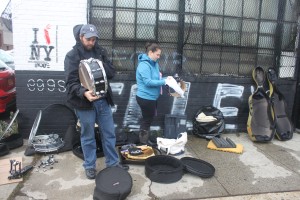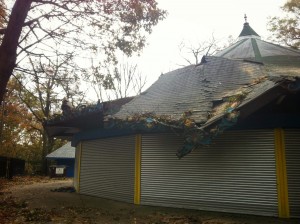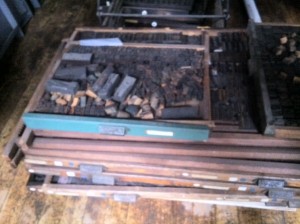Stories of Hurricane Sandy, no doubt, will be told for years. But the hours after the storm were less a time for talk than action as New Yorkers began cleaning up the mess left in Sandy’s wake.
Shaken to the Foundation
STATEN ISLAND – Few houses on Cedar Grove Avenue stood steady on their foundations. None went completely unscathed. At the worst, there were toppled, thoroughly leveled homes that were crushed by the powerful waves just a few feet away. Great pools of water spotted the block at random intervals, leaving no clear path to navigate.
“It’s like a war zone out there,” resident Valerie Hansen said in her home amidst soaked furniture and a strong smell of saltwater that mingled with sewage waste. “Brace yourself.”
Another resident, Larry Becker, agreed. “It’s like we got bombed,” he said. “Everyone is a survivalist now.”
And surviving they were. These residents of Cedar Grove Avenue, a shorefront block in the Oakwood Beach neighborhood, had survived Hurricane Sandy, a storm of historic proportions. The only thing standing between the houses and the water is a small park, making for an unobstructed path for the reported six-to-eight-foot wave that crashed into the block.
(Video: Cedar Grove Ave residents Valerie Hansen and Anthony Murado talk about braving Hurricane Sandy. By: Maya Rajamani)
Those who declined to evacuate said they had yet to see any help from the outside world. Instead, they were organizing to check up on and help each other. Three days after the hurricane no one had come to give them aid, they said. And years ago, they said, their pleas to borough officials for a sea wall had gone unheeded.
Dominick Trainer, a husband and the father of two sons, concentrated on preparing his generator for the cold night. Various tools and piles of material sat in the back of his Dodge pickup truck. On the windshield of the truck was a huge American flag, sullied by mud and ocean water.
“That’s my grandfather’s flag from World War II,” Trainer said. His family found it soon after the storm, torn from its glass display case.
– Eric Jankiewicz and Maya Rajamani
Tunnel Vision
Chris Marche, a Metropolitan Transportation Authority welder, said the subway tunnels didn’t smell all that bad after the water left by Sandy was removed with pumps the size of school buses. But there was still a huge mess: about a foot of mud, oil and debris.
“Everything literally has to be scoured,” said Marche.
“When it really gets bad is the mold,” he added. “There’s also a lot of dead rats floating around down here.”
After the storm, welders went out in teams of two, painstakingly walking the tracks to assess damage not only from water, but inactivity.
“The system is used to running all the time,” he said, “so tracks will expand and contract” causing the rails to crack in weaker areas. “I have to walk 40 blocks one way and 40 blocks the other way looking for hairline fractures.”
Being underground for up to 16 hours a day does have a bright side, according to Marche.
“There’s a lot of camaraderie down here,” he said. “You keep your sanity.”
– Kathleen Caulderwood
Channeling Energy
QUEENS – Residents of hard-hit Broad Channel came together to begin the long battle back from the storm that rampaged through their tight-knit waterfront neighborhood. Check out images of Broad Channel, post-Sandy:
Created with Admarket’s flickrSLiDR.
– Brianne Barry
Attack from Below
QUEENS – Patrick Townsend thought he could beat Hurricane Sandy.
His beloved woodworking shop in the basement of a two-story house in Long Island City was in the mandatory evacuation zone. But Townsend was determined not to leave. He sealed the shop’s doors and windows with silicon, and piled sandbags against the outside walls.
His defenses held – but the seawater found another entryway, through the old drainage system in the floor. By Tuesday noon, Townsend was trying to remove three feet of water using an electric pump he rented for $80 from a store in Brooklyn.
“I have to do this as quickly as possible,” he said. “This is saltwater. It can really damage my equipment.”
– Michalis Paterakis
Soggy Notes
BROOKLYN – Tenants at Scientific Laboratories, a musicians’ practice space in Greenpoint, hauled out damp gear, disposed of soaked rugs, and mopped their spaces and the darkened hallways of the building.
“Everybody was in battle mode,” said Amanda Fucello, whose band rents space in the building.
Near the corner of Gem Street, Daniel Edelman, Karen Halpenny and Jonathan Johansen disassembled and cleaned drum parts. Johansen, who plays with Edelman in God Mode, said that the drumheads were his biggest concern.
“Once they start to warp, the tonality changes. I don’t want to say they’re worthless, but close to it,” he said.

A NEW BEAT: Tenants at Scientific Laboratories, a musicians’ practice space in Brooklyn, dried water-logged instruments. PHOTO BY: Philippe Theise
Another musician carried out two black guitar cases that were dripping water. He laid both down on the sidewalk and opened them, examining a sea foam bass and a light brown hollow body guitar.
Several bands at Sci Labs have upcoming shows, but no one planned to cancel any. Edelman, God Mode’s drummer, said that he would borrow any equipment he needed for the band’s Nov. 8 concert. He said composing, rather than gigging, might suffer in the aftermath of Sandy.
“This is going to put a damper on writing material, that’s for sure,” he said.
– Philippe Theise
‘Pitch Black’
QUEENS – Residents of the Astoria Houses watched water from the East River spill over the riverbank, across a playground, into their yards and into the basement of their New York City Housing Authority development. Then, in two of the development’s 22 buildings, the lights went out.
NYCHA workers who live nearby were assigned to begin emptying the water from the buildings’ basements, but there wasn’t adequate equipment on site. A pump was borrowed from another development, and workers jerry-rigged an ill-fitting hose to begin pumping water out of the building. NYCHA workers told some residents that it could be several days before the basements could be fully emptied and power restored to the buildings.
Many residents said they were concerned for elderly and disabled residents who were unable to navigate the stairwells. Social workers were assigned to check on these residents in the event of an outage, but some residents worried that the dangers would increase in a prolonged outage.
“In the stairwells, it’s black, pitch black,” said Vernon Hinds, 56. “Some of the residents are scared just to go out there. It’s a mission.”
– Skyler Reid
Horse Race
QUEENS – The carousel at Forest Park is no stranger to disaster: its first incarnation was destroyed in a 1966 fire.
The carousel had a close call during Hurricane Sandy, when an 80-foot tree crashed into the roof that shelters the merry-go-round. Now the operators are scrambling to repair the structure to save the ride from more bad weather.

ROOF-TOP PRIORITY: The structure sheltering the Forest Park carousel from the elements needs repair. PHOTO BY: Anne Lagamayo
“We were closed, we had a fantastic season, then Sandy came and gave us a surprise,” said David Galst, director of operations for New York Carousel Entertainment. “We did everything we could to prevent damage.”
– Anne Lagamayo
Oil and Water
BROOKLYN – Sandy spurred some environmental advocates to take a new look at Newtown Creek.
The Newtown Creek Alliance, a community-based organization dedicated to restoring and revitalizing the area around the creek, said it spotted pollution in the water.
“We have observed oil sheens and gloopy debris left behind in the flooded areas,” said Kate Zidar, executive director of the group. “And (we) urge people to wash well if you contact flood zone-muck.”
Linda Tseng, whose high-rise apartment looks out onto the northern horizon of Greenpoint where the Newtown Creek marks the Brooklyn border, said she wasn’t concerned, pointing out that much of the area had been cleaned up since the site was given Superfund status in 2010.
“I don’t know if I can be too mad,” said Tseng. “I have to give them credit for giving everyone in Zone A mandatory evacuation.”
– Laura Lorenzetti
A Pressing Concern
MANHATTAN – “Feel like sorting type?” shouted an employee to bystanders outside of Bowne & Co. Stationers in Lower Manhtattan.
Owned by the South Street Seaport Museum, Bowne & Co. houses 19th
century letterpresses that are still used to produce paper goods for the store. Employees and volunteers who work at Manhattan’s oldest existing business were scrambling to come up with a plan on how best to rescue damaged materials. The store’s once all-white walls now show a brown discoloration two and a half feet high, indicating the level Hurricane Sandy waters reached.
The printing shop’s employees had prepared for potential flooding by placing merchandise on countertops, but equipment was still damaged by the flood. Wooden-blocks of type got soaked.

OLD TYPE: The Bowne & Co. printing shop at the South Street Seaport was flooded by Sandy. PHOTO BY: Amy Eley
Jared Moran, 28, was walking past the stationers on Water Street when an employee asked for his help. “I’m supposed to be working from home,” said Moran. Instead, he sorted wet letter blocks inside the shop.
Bowne & Co. had been scheduled next week to debut its expansion into a storefront adjacent to its original location. The grand reopening has been delayed.
Susan Henshaw Jones, president of the South Street Seaport Museum, told the Downtown Alliance that the lobby of the museum, located a few steps from the stationers, had five feet of water in its first floor lobby. All of the exhibitions in the museum’s main Water Street location, though, were unharmed.
– Amy Eley
Sign of the Times
MANHATTAN – Andy didn’t like Sandy. The storm shredded the sign above the store at Andy’s Deli, across the street from the Museum of Natural History. “I came in from Queens. I took my bicycle over the bridge. There were a lot of people doing that,” said Carlos, one of the cooks. Outside, two other employees struggled with the collapsing sign, while across the street tourists snapped pictures of downed trees in Central Park.
On 72nd Street and Broadway, Raymond Hailes, an employee at West, a clothing store, prepared to reopen the shop. “My lights went out for a second, that’s all,” said Hailes, of Harlem. “Everyone wants to live downtown. Not so much anymore, huh?”
– Jesse Metzger
High Wire Drama
BROOKLYN – The normally quiet block of Troy Avenue in East Flatbush lit up as Sandy roared through. “I was scared,” said Sheila Lewis, an elderly immigrant from Guyana.
Lewis lives a few paces from a scorched electrical pole. Earlier that day, she said, wires struck by a falling tree sparked up, causing a flame to travel the full length of the street. She switched off her lights and called 911.
“Thank God the tree didn’t fall back on top [my] house,” she said.

DANGEROUS CHARGE: Con Ed workers examined wires from a fallen tree in Brooklyn. PHOTO BY: Mikhael Simmonds
Lewis’ neighbor, Villafana Gillian, 38, had a bigger scare. The electrical fire from the pole ran directly into her home. She called for help after smelling smoke, then took her family outside and sat in their car, waiting. Firefighters dug through walls and floors to get to the scorching wires.
The neighborhood awoke to find the tree sprawled across the roadway, tangled in electrical wires as the scent of smoke drifted in the air.
– Mikhael Simmonds
Sense of Smell
LONG ISLAND – Wearing tall boots and thick rubber gloves, Mike Rinaldo picked up branches and garbage, mostly plastic wrappers and bottles, that the surging storm water left in his Patchogue front yard – a yard still covered with a few inches of water.
At one point he found a large, empty conch shell. Inside his living room, the floor and furniture were covered with wet mud, he said.
“It’s the mud and the smell,” he said. “That’s going to keep us out of here for weeks.”
Down the street and further inland, Juan Lago also said the smell left by the receding floodwaters was the worst part.
“It’s a mixture of the Bay, sewage, oil and dead worms,” he said. “It’ll be weeks before it really goes away.”
– Andrew Welsch


